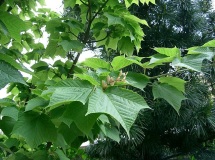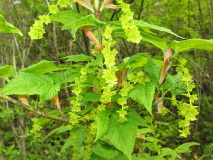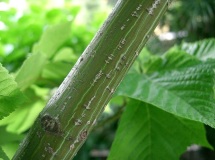- Home
- >
- Broadleaved Tree Seeds A-I by Latin Name
- >
- Redvein Maple (acer rufinerve)
Redvein Maple (acer rufinerve)
SKU:
£1.10
1.1
9.5
£1.10 - £9.50
Unavailable
per item
Seed Prices
1 gram (approx 32 seeds) £1.10
2 grams (approx 64 seeds) £1.75
5 grams (approx 160 seeds) £2.75
10 grams (approx 320 seeds) £4.50
25 grams (approx 640 seeds) £9.50
Please note that these seeds require a minimum of 12 weeks stratification before they will germinate. For a March 1st sowing this should begin around December 7th -further information detailed below
Use the drop down button below to select the seed quantity
Photo Credits
Leaves -KENPEI's photo, CC BY-SA 3.0, https://commons.wikimedia.org/w/index.php?curid=2089484
Flowers -Qwert1234 - Qwert1234's file, CC BY-SA 3.0, https://commons.wikimedia.org/w/index.php?curid=26437949
Stem -KENPEI - KENPEI's photo, CC BY-SA 3.0, https://commons.wikimedia.org/w/index.php?curid=1843934
Leaves -KENPEI's photo, CC BY-SA 3.0, https://commons.wikimedia.org/w/index.php?curid=2089484
Flowers -Qwert1234 - Qwert1234's file, CC BY-SA 3.0, https://commons.wikimedia.org/w/index.php?curid=26437949
Stem -KENPEI - KENPEI's photo, CC BY-SA 3.0, https://commons.wikimedia.org/w/index.php?curid=1843934
A beautiful maple native to mountain forests of Japan, It is a small deciduous tree growing to a height of 8–15m, with a trunk up to 40 cm diameter that is mainly grown for its gorgeously ornamental bark. On young trees this is a smooth, olive-green with regular narrow vertical pale green to greyish stripes that looks fabulous in winter and always attracts attention. .
This is one of the most commonly planted snake bark maples it is a small tree with an arching habit that is suitable for most gardens. It is hardy and fast growing with beautiful autumn colours turning to yellows, bright orange and red.
Grows best in a moist but well-drained soil but is quite adaptable to a wide range of soil types from acid sandy soil though to clays and soils over limestone.
Having grown many of these from seed I find this species easy to germinate, it grows very fast with its stripes forming from as early as 2 years of age.
These seeds have a relatively short and uncomplicated dormancy that is relatively easy to break down. Full information on how to do this is included with every order.
This is one of the most commonly planted snake bark maples it is a small tree with an arching habit that is suitable for most gardens. It is hardy and fast growing with beautiful autumn colours turning to yellows, bright orange and red.
Grows best in a moist but well-drained soil but is quite adaptable to a wide range of soil types from acid sandy soil though to clays and soils over limestone.
Having grown many of these from seed I find this species easy to germinate, it grows very fast with its stripes forming from as early as 2 years of age.
These seeds have a relatively short and uncomplicated dormancy that is relatively easy to break down. Full information on how to do this is included with every order.
Germination, Sowing and After Care Information for
Red Vein Maple (acer rufinerve)
Maple seeds of this species have a deep dormancy within them, this requires a degree of patience to overcome and it is usually quite easy to get high levels of germination if the correct procedures are followed.
First prepare a free draining substrate into which the seeds are to be mixed, this can be a 50/50 mixture of compost and sharp sand, or perlite, vermiculite. The chosen substrate needs to be moist (but not wet), if you can squeeze water out of it with your hand it is too wet and your seeds may drown and die. Mix the seeds into the substrate, making sure that their is enough volume of material to keep the seeds separated. Place the seed mixture into a clear plastic bag (freezer bags, especially zip-lock bags are very useful for this -provided a little gap is left in the seal for air exchange) If it is not a zip-lock type bag it needs to be loosely tied. Then write the date on the bag so that you know when the pretreatment was started.
Next the seeds are required to undergo a cold period to break the dormancy, this is easily achieved by placing the bag of seeds and compost in the fridge at (4 Celsius or 39F) for around 12 weeks. It is quite possible for the seeds to germinate in the bag at these temperatures when they are ready to do so, if they do, just remove them from the bag and carefully plant them up. When the period of pre treatment has finished the seed should be ready to be planted. Small quantities can be sown in pots or seed trays filled with a good quality compost and cover them with a thin layer of compost no more than 1cm deep. For larger quantities it is easiest to sow the seeds in a well prepared seedbed outdoors once the warm and cold pretreatments have finished and wait for the seedlings to appear.
It has also been found that fluctuating pretreatment temperatures can give the best germination results and I have myself had excellent results by keeping the mixed seeds in a cold shed through the winter for the cold stage of their pretreatment and allowing the temperature to fluctuate naturally. Ungerminated seeds can have the whole warm and cold process repeated again to enable more seeds to germinate.
Do not expose newly sown seeds to high temperatures (above 25 Celsius). Keep the seedlings well watered and weed free. Growth in the first year is usually between 10 and 40cm depending on the time of germination and cultural techniques and developing seedlings are usually trouble free. Allow them to grow for 1 or 2 years before planting them in a permanent position
First prepare a free draining substrate into which the seeds are to be mixed, this can be a 50/50 mixture of compost and sharp sand, or perlite, vermiculite. The chosen substrate needs to be moist (but not wet), if you can squeeze water out of it with your hand it is too wet and your seeds may drown and die. Mix the seeds into the substrate, making sure that their is enough volume of material to keep the seeds separated. Place the seed mixture into a clear plastic bag (freezer bags, especially zip-lock bags are very useful for this -provided a little gap is left in the seal for air exchange) If it is not a zip-lock type bag it needs to be loosely tied. Then write the date on the bag so that you know when the pretreatment was started.
Next the seeds are required to undergo a cold period to break the dormancy, this is easily achieved by placing the bag of seeds and compost in the fridge at (4 Celsius or 39F) for around 12 weeks. It is quite possible for the seeds to germinate in the bag at these temperatures when they are ready to do so, if they do, just remove them from the bag and carefully plant them up. When the period of pre treatment has finished the seed should be ready to be planted. Small quantities can be sown in pots or seed trays filled with a good quality compost and cover them with a thin layer of compost no more than 1cm deep. For larger quantities it is easiest to sow the seeds in a well prepared seedbed outdoors once the warm and cold pretreatments have finished and wait for the seedlings to appear.
It has also been found that fluctuating pretreatment temperatures can give the best germination results and I have myself had excellent results by keeping the mixed seeds in a cold shed through the winter for the cold stage of their pretreatment and allowing the temperature to fluctuate naturally. Ungerminated seeds can have the whole warm and cold process repeated again to enable more seeds to germinate.
Do not expose newly sown seeds to high temperatures (above 25 Celsius). Keep the seedlings well watered and weed free. Growth in the first year is usually between 10 and 40cm depending on the time of germination and cultural techniques and developing seedlings are usually trouble free. Allow them to grow for 1 or 2 years before planting them in a permanent position






